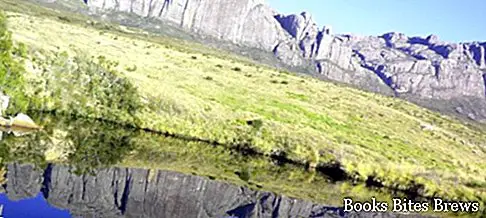A succession of disconnected forms, where the imaginative nuances of the minerals created by the waters contrast with the silvery colors of the rocks of this mountain range of Madagascar, between tree-like heather and wonderful orchids.
Andringitra national park
Located just north of the Tropic of Capricorn and a hundred kilometers from the Indian Ocean, this mountain range is 62 km long and an average of 3 km wide, the largest peak being the Body Peak with its 2658 meters.
Thinned at its ends, the chain disappears to the south, near the Ivohibe hill, then rises again, taking on the appearance of a peak that rises up to 2069 meters.
To the north, it fragments into a series of gigantic domes up to the bend of the Zomandao River.
Virtually the Andringitra represents the major element that limits the Highlands of the East.
In the past, this high barrier was a refuge for the Betsileo populations of the lowlands, when they had to take shelter from the incursions of the Sakalavas or Merina.
The structure of the Andringitra is quite simple, with the syenite or granite blade that differs from north to south, leaving differential erosion the possibility of acting on the hardest banks, characterized by longitudinal or radially arranged fractures.
The greatest naturalistic interest is the morphological details and the presence of vegetation at various altitudes.
From north to south there are various morphological units, from the great monoliths of the north, which reach 500 meters in height, to the ramparts of the center, in addition to the mountainous ridge of the south and the Ivohibe peak in the far south.
Depending on whether you explore it from the east or the west, the mountain shows great contrasts.
The central portion gives meaning to the name of the chain, as Andringitra means desert of stones.
Recommended readings- Andrafiabe: the most beautiful cave in Madagascar
- Nosy Be: what to see on the island off Madagascar
- Madagascar: useful information
- Andringitra: chain and national park of Madagascar
- Ankarana: national park of Madagascar
In fact, it is made up of a set of masses shaped by a very strong erosion, a factor that many remember of the Dolomites.
This barrier constitutes a shock front for the trade winds that bring it humidity, thanks to the abundant annual rains.
Domes and ramparts have slopes for a difference in height of several hundred meters, where the outflow of the water has dug deep furrows.
It is these natural grooves that make the appearance of the mountain unusual, fueling the imagination of the populations and arousing the interest of tourists.
Only Itatiaia, in Brazil, with its Agulhas Negras, is able to stand comparison, despite the lower development.
Stone basins and sphinxes multiply at the level of fractures or material changes.
The western part, on the contrary, is a long humpback that the forest invades and gradually covers.
The succession of vegetation between 1000 and 2500 meters reproduces, in miniature and at a lower altitude of 2000 meters, what is found in the giants of East Africa.
The orchid-rich forest of orchids gives way to a dense formation, where the magnificent garlands of the usnea abound.
Above 2000 meters the heath begins, where heather grows, having a tree-like shape, which reaches a minimum of 3 meters to reach a maximum of 5.
The central stony desert hosts a carpet of evergreen plants that bloom in September, going further you enter the cold area, where the frost is felt for the entire dry season, which extends from July to October.
In 1925 Perrier de la Bathie obtained from the French administration that this place was declared protected, establishing a natural reserve covering 35,000 hectares.




